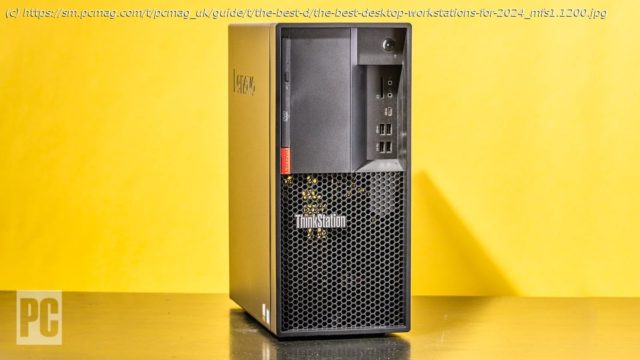Meet the most serious PCs on the planet: desktop workstations, certified to crunch through the most demanding design and rendering jobs and process the most intimidating datasets. Here’s what you need to know as you shop for a genuine heavyweight (even if it’s small in size).
Workstations are the sharpest tools in the desktop PC world, purpose-built for everything from professional photo and video editing to scientific analysis, computer-aided design (CAD), and Hollywood-level computer-generated imagery and 3D rendering. These specialized computers are available for nearly any budget, from not much more than a normal desktop to well above the sticker of a sports car.
Anyone using extra-tough software (decidedly not something as simple as Microsoft 365 or Google Workspace) or looking for a highly reliable PC for intensive tasks should consider a workstation over a traditional desktop.
Before you go workstation shopping, you should know they can be some of the most confusing computers to purchase because of their sheer configurability and a knack for offering options you’ve probably never heard of. Below is a breakout of our top picks among workstations we’ve tested. Following that is a buying guide that delves into all aspects of workstation buying, including professional-grade graphics cards, error-correcting memory, workstation-class CPUs, and warranty considerations.Why We Picked It
The Z2 Tower G9 isn’t HP’s top-of-the-line workstation—the Z4, Z6, and Z8 stand above it if you want up to 1.5TB of RAM or 56 cores of dual-Xeon processing power—but it’s no entry-level weakling. Its roughly $1,000 starting price is a good jumping off point, and it can support Intel CPUs up to the Core i9 K series, 128GB of memory, and 48TB of storage. The Z2 Tower can be configured for almost any job from financial analysis to 3D modeling or CGI rendering and features HP’s exceptional Wolf Security, which ranges from AI malware protection to automatic repair of a corrupted BIOS and virtual-machine sandboxing of apps and webpages.Who It’s For
With independent software vendor (ISV) certifications aplenty and a slew of component choices, few offices need more than this workstation workhorse can provide. The Z2 may not offer exotica like liquid CPU cooling (though its multiple cooling fans are surprisingly quiet in operation), but there are few professional tasks it can’t handle.Why We Picked It
You can find plenty of ways to spend a load of money in the workstation category. The HP Z4 G5 provides a decent starting point, priced more than entry-level systems but with plenty of room to configure upward. Even the base model features Intel Xeon processors. Our $6,691 review model packs blistering speed with its Xeon w7-2495X CPU and Nvidia RTX A4000 GPU. Consider also the HP Z6 G5 if you need even more power.Who It’s For
If you need to configure the exact right workstation (or a fleet of them) for your needs and budget, the Z4 G5 likely has the options you’re looking for. The upgrades do bring the price up quickly, but between the pro-grade build, use-case flexibility, and quiet operation, demanding pro users will be satisfied.
Why We Picked It
Major manufacturers like Dell, HP, and Lenovo are the more usual names in the workstation space, but Falcon Northwest has been making blazing-fast PCs for years, and the AMD Ryzen Threadripper Pro-based Talon leads the pack. Our review configuration’s 64-core processor, 256GB of memory, and Nvidia RTX 6000 GPU topped the charts in our benchmark testing, in some cases even earning noticeable clearance over its fastest rivals. All workstations in this tier are hyper expensive, but most surprising from a boutique vendor, the Talon comes in at significantly less money than the nearest competitor despite the class-leading speed and quality build. It runs quietly, comes with a three-year warranty, and is a really well put together system.Who It’s For
Simply put, this system is meant for users who need maximum processing power out of a single CPU. It’s even a more affordable way to approach this speed compared to some alternatives, making the speed and build quality all the more astounding. Most users absolutely don’t need this much power, but if you’re shopping for workstations in this tier, you know who you are. The most demanding data and content creation workloads will utilize all of the cores and RAM on offer here happily. Scaling can get quite expensive, but it’s a highly customizable desktop, and should be your top consideration if processing power is your priority.Why We Picked It
Most workstation buyers care more about power, expandability, and ISV certifications than what brand of processor makes up the engine, but Dell’s Precision 7875 makes a strong case for swimming against the Intel tide thanks to AMD’s Ryzen Threadripper Pro chips. There are several hyper-powerful options; our review unit packs a mighty 96 processor cores into a single CPU. Quite a few applications work better in a single- than a dual-CPU environment, and the Precision 7875 can tackle the most brutal dataset analysis or visual rendering jobs. The tower is versatile and quiet, too. It posted whip-fast results on our benchmark tests, though Falcon Northwest’s Talon is even faster (and less expensive). Dell is a bigger, traditional retailer for professional users if Falcon Northwest’s build doesn’t work for you.Who It’s For
If your workflow requires maximum multicore muscle, and you would prefer to get it from a major manufacturer like Dell, this is the company’s mightiest tower. Massive datasets, media creation, and other pro-grade workloads will gladly take all the power and cores this system can throw their way. This Precision is no value play, because scaling and base costs are expensive, but this is a professional-centric option with all the features and support you’re looking for.Why We Picked It
The most demanding workstation users need sheer muscle to churn through their workloads with as little downtime as possible, and the Fury is nearly as fast as the Threadripper Pro-based ThinkStation. Media, VFX, and AI creators will appreciate the raw power of the Intel Xeon W9-3495X chip and four—yes four—Nvidia RTX A6000 GPUs in our review unit. Many applications work better in a single- than a dual-CPU environment, and the Fury can tear through the biggest datasets or rendering tasks. Who It’s For
Professionals in the arenas mentioned above (and similar creative fields) are generally the only users who need this much power; you know who you are if you’re shopping workstations. The Fury, in particular, boasts a very high ceiling for expanding storage, memory, and GPU count. Of course, you may need not configure or expand your unit as highly as our review model, but it’s important to know that you can, depending on your workload. The P620’s Ryzen Threadripper Pro processor delivered more performance, but not by a huge margin. The Fury’s versatility may better suit your needs.Why We Picked It
As an upgrade on the M1 Max model, the M1 Ultra version of the Mac Studio deeply impressed us, but it’s been easily superseded by its next-generation successor. It must be said first that the M2 Ultra model starts at $3,999, and the particular M2 Ultra version we reviewed cost an exorbitant $8,799 as configured. That’s one of the highest costs per cubic inch we’ve seen from a desktop computer—it’s just 7.7 inches square and 3.7 inches high—but crams in a colossal 24 processing cores and up to 76 graphics cores, as well as up to 192GB of memory and as much as 8TB of solid-state storage. (Note that the latter’s in a proprietary format instead of standard M.2, continuing Apple’s tradition of thumbing its nose at third-party upgrades.) Needless to say, our unit delivered extremely fast high-end performance, despite the box’s size.Who It’s For
If you need a serious professional system but prefer macOS to Windows or Linux, the flagship Mac Studio is Apple’s ultimate solution short of a new Mac Pro. An exotic copper cooling block and vapor chamber keep the diminutive desktop from overheating, while the unibody aluminum chassis contains half a dozen Thunderbolt 4 ports, two USB-A ports, an HDMI monitor port, and a 10Gbps Ethernet jack. It is expensive on its own but also competitively priced among workstations in this tier. The M2 Ultra Studio screams through both processing- and- graphics-intensive apps as well as benchmarks, keeping Apple relevant in the workstation market.Why We Picked It
Most desktop workstation buyers want tons of expandability and upgradability. HP’s Z2 Mini G9 doesn’t have those, but it has awesome performance, impressive connectivity, and surprising serviceability for a PC only 2.7 by 8.3 by 8.6 inches big. Though it can hide under a desk or behind a monitor with an optional VESA mount, the Z2 Mini accommodates the 125-watt processors you’ll find in full-size towers, such as our test unit’s flagship Intel Core i9-12900K, and an industry-standard graphics card. The latter must be a half-length, half-height GPU powered by the PCI Express slot, but the 12GB Nvidia RTX A2000 in our review system is certainly no slouch.Who It’s For
The Z2 Mini G9 carries the independent software vendor (ISV) certifications of its bigger desktop brothers and HP’s ZBook mobile workstations, making it a great choice for 2D and light 3D design and CGI rendering as well as video editing, dataset analysis, and scientific and engineering apps. Up to 64GB of memory and 8TB of storage give you plenty of headroom, while two « flex banks » can be configured with a dizzying array of ports. Apparently nobody told it that it wasn’t a tower.Why We Picked It
You’re welcome to use the Lenovo ThinkStation P360 Ultra for Microsoft Word and Excel, but it’s really overkill for office apps—in fact, it stands close to HP’s Z2 Mini G9 as a potent mini workstation. Measuring 8.7 by 3.4 by 7.9 inches (HWD), it weighs less than four pounds, but its slide-out internal frame holds up to a Core i9-12900 CPU, 64GB of RAM, two M.2 solid-state drives plus a 2.5-inch SATA hard drive, and an Nvidia RTX A5000 graphics card.Who It’s For
With ISV certifications and enterprise-class security, the P360 Ultra is a more-than-worthy alternative to the Z2 Mini or Apple’s Mac Studio. Two Thunderbolt 4 ports join a USB-A 3.2 port and audio jack up front, with Gigabit and 2.5Gbps Ethernet ports, four more USB 3.2 ports, and three DisplayPorts (plus the GPU’s four mini DisplayPorts) around back.






